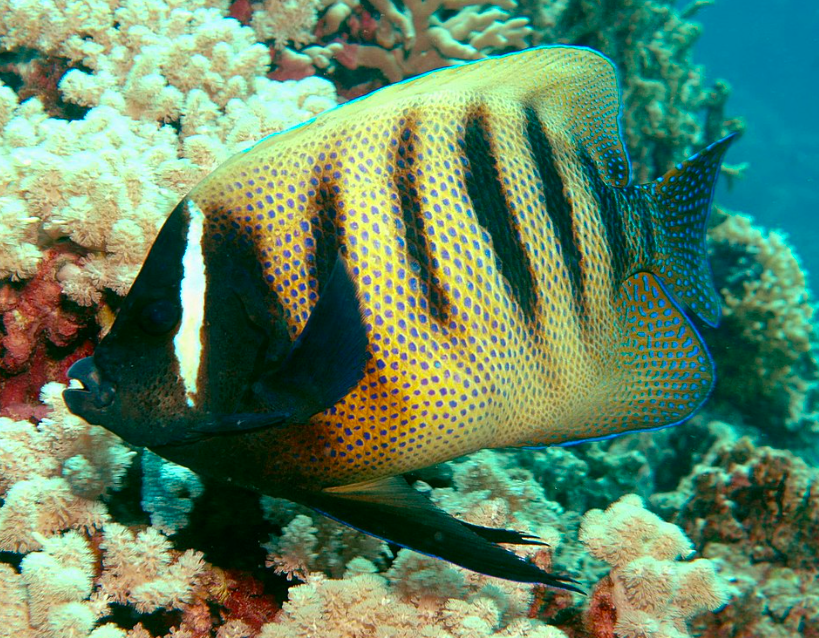 Image 1 of 1
Image 1 of 1


Angel- Half Black
The term "angel half black" typically refers to a specific variety of angelfish known as the "Half Black Angelfish" (Centropyge vrolikii). The name "half black" comes from the distinctive coloration of this angelfish, which features a prominent black coloration covering about half of its body, usually from the front half of the body to the tail fin. The front half of the fish is often adorned with vibrant colors and patterns.
Here are some key characteristics and care guidelines for Half Black Angelfish:
Appearance: The front half of the fish typically exhibits vibrant colors, such as shades of orange, yellow, or blue, while the rear half is predominantly black. This coloration can vary slightly among individual fish.
Size: Half Black Angelfish are relatively small, reaching lengths of about 3 to 4 inches (7.5 to 10 cm) when fully grown.
Tank Requirements: Half Black Angelfish can be kept in a saltwater aquarium with a minimum tank size of 30 gallons. Ensure proper filtration, water quality, and stable parameters (temperature, salinity, pH).
Water Parameters: Maintain a temperature range of 72-78°F (22-26°C), specific gravity of 1.020-1.025, and a pH level between 8.1 and 8.4.
Diet: These angelfish are omnivorous, so provide a varied diet that includes high-quality flakes, pellets, frozen foods, and live or frozen brine shrimp and mysis shrimp. They may also graze on algae and small invertebrates in the aquarium.
Compatibility: Half Black Angelfish are generally considered peaceful but can be territorial, especially when they mature. They can be kept with other peaceful fish in a community aquarium. Be cautious when adding other angelfish, as they can be aggressive towards their own kind.
Coral Compatibility: They are usually considered reef-safe and won't harm most corals or invertebrates in a reef aquarium. However, individual behavior can vary.
Hiding Spots: Provide hiding spots and live rock for them to explore and establish territories.
Quarantine: Quarantine new fish before introducing them to the main tank to prevent the spread of diseases or parasites.
Observation: Keep a close watch on the health and behavior of your Half Black Angelfish, as well as interactions with other tank inhabitants.
The Half Black Angelfish is known for its striking appearance and can be an attractive addition to a marine aquarium. Proper care and attention to their specific needs will help ensure their well-being in your tank.
The term "angel half black" typically refers to a specific variety of angelfish known as the "Half Black Angelfish" (Centropyge vrolikii). The name "half black" comes from the distinctive coloration of this angelfish, which features a prominent black coloration covering about half of its body, usually from the front half of the body to the tail fin. The front half of the fish is often adorned with vibrant colors and patterns.
Here are some key characteristics and care guidelines for Half Black Angelfish:
Appearance: The front half of the fish typically exhibits vibrant colors, such as shades of orange, yellow, or blue, while the rear half is predominantly black. This coloration can vary slightly among individual fish.
Size: Half Black Angelfish are relatively small, reaching lengths of about 3 to 4 inches (7.5 to 10 cm) when fully grown.
Tank Requirements: Half Black Angelfish can be kept in a saltwater aquarium with a minimum tank size of 30 gallons. Ensure proper filtration, water quality, and stable parameters (temperature, salinity, pH).
Water Parameters: Maintain a temperature range of 72-78°F (22-26°C), specific gravity of 1.020-1.025, and a pH level between 8.1 and 8.4.
Diet: These angelfish are omnivorous, so provide a varied diet that includes high-quality flakes, pellets, frozen foods, and live or frozen brine shrimp and mysis shrimp. They may also graze on algae and small invertebrates in the aquarium.
Compatibility: Half Black Angelfish are generally considered peaceful but can be territorial, especially when they mature. They can be kept with other peaceful fish in a community aquarium. Be cautious when adding other angelfish, as they can be aggressive towards their own kind.
Coral Compatibility: They are usually considered reef-safe and won't harm most corals or invertebrates in a reef aquarium. However, individual behavior can vary.
Hiding Spots: Provide hiding spots and live rock for them to explore and establish territories.
Quarantine: Quarantine new fish before introducing them to the main tank to prevent the spread of diseases or parasites.
Observation: Keep a close watch on the health and behavior of your Half Black Angelfish, as well as interactions with other tank inhabitants.
The Half Black Angelfish is known for its striking appearance and can be an attractive addition to a marine aquarium. Proper care and attention to their specific needs will help ensure their well-being in your tank.






